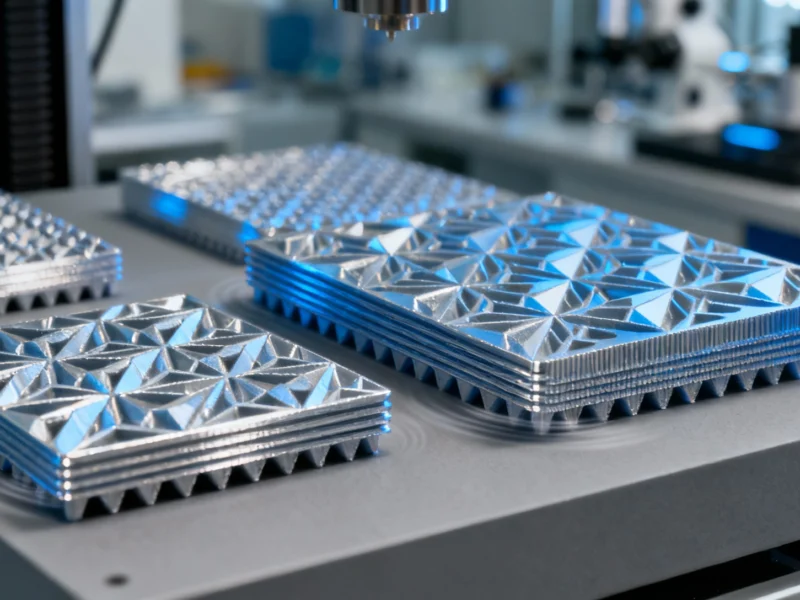TITLE: 3D-Printed Metamaterials Revolutionize Vibration Control Through Complex Geometry
META_DESCRIPTION: University of Michigan and Air Force Research Laboratory develop 3D-printed metamaterials using complex geometry to dampen mechanical vibrations for transportation and engineering.
EXCERPT: Researchers have demonstrated how 3D-printed metamaterials with intricate geometric structures can effectively suppress mechanical vibrations. This breakthrough combines advanced manufacturing with topological physics to create materials with unprecedented vibration-dampening properties.
Revolutionary Approach to Vibration Control
In a significant advancement for materials science, researchers from the University of Michigan and the Air Force Research Laboratory have developed groundbreaking 3D-printed metamaterials that utilize complex geometric structures to effectively suppress mechanical vibrations. Unlike traditional approaches that focus on chemical composition, this innovation harnesses precisely engineered geometry to create materials with exceptional vibration-dampening capabilities. The research, published in Physical Review Applied, represents a paradigm shift in how we approach material design and mechanical property engineering.
Bridging Theoretical Concepts with Practical Manufacturing
“That’s where the real novelty is. We have the realization: We can actually make these things,” said James McInerney, a research associate at the AFRL and former postdoctoral fellow at U-M. The team’s work demonstrates how advanced 3D printing technologies can transform theoretical concepts into tangible materials with practical applications. This manufacturing breakthrough enables the creation of structures that were previously impossible to fabricate using conventional methods, opening new possibilities for vibration control across multiple industries.
Geometric Innovation Over Chemical Modification
According to Xiaoming Mao, U-M physics professor and study co-author, “For centuries, humans have improved materials by altering their chemistry. Our work builds on the field of metamaterials, where it is geometry—rather than chemistry—that gives rise to unusual and useful properties.” This approach mirrors natural structures like human bones and plankton shells, which achieve remarkable mechanical performance through complex geometric arrangements rather than unique material composition. The research demonstrates that by controlling geometry at multiple scales, materials can exhibit properties far beyond those of their constituent substances.
Historical Foundations and Modern Applications
The research builds upon centuries of mechanical theory, including the work of 19th-century physicist James Clerk Maxwell, who developed design principles for stable structures with repeating subunits. Modern topological physics, which studies behaviors at material boundaries and edges, provides the theoretical framework for understanding how these geometric arrangements affect vibration propagation. As McInerney notes, “About a decade ago, there was a seminal publication that found out that Maxwell lattices can exhibit a topological phase,” which the current research has now translated into practical vibration-dampening structures.
Advanced Manufacturing Meets Complex Design
The team utilized advanced 3D printing technology to create intricate tubular structures resembling traditional Japanese basket weaving patterns, known as kagome tubes. These structures feature interconnected inner and outer layers that effectively impede vibration transmission while maintaining structural integrity. The manufacturing precision required for these geometries was previously unattainable, highlighting how advanced fabrication technologies are enabling new material capabilities. The research demonstrates that we can now “manufacture materials from the ground up with crazy precision,” as McInerney describes it.
Practical Applications and Future Potential
The vibration-dampening metamaterials show promise for numerous applications, including transportation systems, civil engineering structures, and precision manufacturing equipment. However, the research also revealed important tradeoffs—structures that excel at vibration suppression typically support less weight, presenting design challenges that require careful balancing of performance requirements. This parallels challenges seen in other advanced material applications, such as those documented in studies of hydrothermal systems and space exploration components.
Research Validation and Experimental Confirmation
The team validated their theoretical models by creating physical prototypes using 3D-printed nylon, confirming that the geometric structures effectively suppress mechanical vibrations as predicted. The experimental results, detailed in their published study, demonstrate the practical viability of these theoretical concepts. This experimental validation represents a crucial step toward real-world implementation, similar to verification processes used in other scientific domains, including those examining nanoscale technologies and advanced manufacturing systems.
Collaborative Research Effort
The interdisciplinary team included researchers from multiple institutions, including Serife Tol from U-M’s mechanical engineering department, Othman Oudghiri-Idrissi from the University of Texas, and Carson Willey and Abigail Juhl from the AFRL. This collaborative approach reflects the growing trend in scientific research toward combining expertise across traditional disciplinary boundaries. The successful integration of physics theory, mechanical engineering principles, and advanced manufacturing expertise demonstrates how multidisciplinary teams can tackle complex engineering challenges more effectively than isolated research groups.
Future Directions and Standardization Challenges
As McInerney explains, “Because we have such new behaviors, we’re still uncovering not just the models, but the way that we would test them, the conclusions we would draw from the tests and how we would implement those conclusions into a design process.” The development of these novel materials necessitates new testing methodologies and characterization standards, similar to challenges faced in other emerging technology sectors, including those addressing international technology governance. Establishing these standards will be crucial for widespread adoption and commercial application of vibration-dampening metamaterials.
Broader Implications for Materials Science
The research represents a significant step toward what McInerney describes as “creating very specifically architectured materials” that differ fundamentally from conventional materials. By focusing on geometric design rather than chemical composition, this approach enables the creation of materials with tailored mechanical properties for specific applications. This paradigm shift in material design has implications beyond vibration control, potentially influencing how we approach material development across multiple engineering disciplines and opening new possibilities for creating materials with previously unattainable properties.



